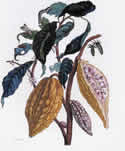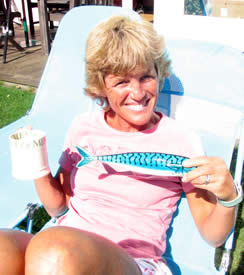 2 September 2005 Topsham, Devon
2 September 2005 Topsham, Devon Dammit, for the fourth year running Kim has whooped the pants off me. It’s been a great year for boating and that means we’ve spent a lot of time at sea, fishing. Or in my case, trying to. And while I’ve struggled to catch a single thing, Kim meanwhile has been pulling in mackerel by the dozen.
It just doesn’t make sense. We purchased two identical mackerel lines this summer, we go a couple of miles off shore, turn off the engine, and throw the lines overboard. Kim invariable gets a bite, almost immediately, and hauls in a silvery, glistening, slippery, shiny, yes, dammit, beautiful fish. Then another. And another. And another. Me: not even a nibble.
“Let’s change sides,” I say sulkily, certain that the shadow of the boat, or some other significant factor, is the cause of my lack of success. But no, as soon as we have switched over, she twitches in excitement as she feels the catch, and then begins hauling in a fish! Meanwhile, I sit stupidly dangling the bloody line overboard, bobbing my arm up and down like a bozo, pointlessly and fruitlessly.
“There’s absolutely no skill in mackerel fishing,” I comment, to no one in particular. “They are such stupid fish, they will go for anything at all.” This is true: we are fishing off hand lines with no more than brightly coloured feathers attached to a string of hooks. Why then, do they always go for hers and not mine?
The really annoying thing about it, I’m afraid I have to say, is Kim’s attitude. Now anyone who knows Kim would agree that she is the least self-congratulatory, triumphal, yee-high, aren’t-I-great sort of person you’ll ever meet. She is modest in the extreme. But not when it comes to fishing. She has become, well, unbearably, objectionably smug about her prowess. Every time she catches a bloody fish, she puffs up with the most extreme pleasure; every time I pull in an empty line, she can hardly stifle the guffaws of mirth as she says, very unconvincingly, choking back tears of laughter, ‘Bad luck’.
Bad luck? Perhaps. But in fact, it’s reached the point where I have finally if reluctantly had to concede that yes, she is a better mackerel fisherperson than me. There is no shame in admitting it. I mean, it doesn’t signify that I am any less of a person, does it? She simply seems to have the knack and fish are for some inexplicable reason attracted to her line above all others. It’s probably genetic. Nature not nurture.
‘Mummy Mackerel’ we’ve taken to calling her, every time she pulls in a fish. It is name she wears with the utmost pride. It’s now accepted in this family that when it comes to fishing, I am a dismal failure, while Kim is nothing less than a champion, a world beater: Mummy Mackerel.
Today is our anniversary. We have been married 27 years. I wonder what to give her as a present. I go shopping with Bella and in a local art gallery we find just the perfect thing: a beautifully handcrafted and painted ceramic mackerel. This is the ideal offering in homage to her greatness, to her fishing prowess: Mummy Mackerel.

Kim loves the ceramic fish, and I can tell that she is quite touched by my acknowledgement (finally if grudgingly) of her superiority, something that has been blatantly obvious to everyone but me for the past several years.
She then gives me my anniversary present, or presents. Lots of little packages all wrapped up nicely. I open the first little package. A pair of lead weights. Next a lure shaped like a little fish, with vicious three-prong hooks. A packet of swivels. A fishing reel. And finally, a long boat rod.
“For bass fishing!” she says, handing me a book, ‘How to catch bass’ (it wasn't sub-titled 'For dummies' but it might as well have been).
I speed read the whole 215 pages in, what, fifteen minutes or so flat and feel intuitively that I already have a very good understanding of the task in hand. Now let’s be honest (as we must be): mackerel may be very tasty, but as every schoolboy knows, they are as common as muck, aren’t they? And as we’d all agree, just about anyone can catch them, right? But sea bass, the emperor of the sea, the tastiest and most prized fish of all, the most demanding to catch (so says the book), requiring skill, cunning, courage, local knowledge and, yes, perhaps a touch of luck.
Already I begin licking my lips in anticipation, thinking about
bar au beurre blanc, branzino arrosto, sea bass fillets deep-fried in tempura batter (with such treatment the fish takes on the creamiest and sweetest flavour), steamed sea bass Chinese style with spring onions and ginger…
Mummy Mackerel indeed: I am soon to become…King Bass!
So I take Guy and Bella into school and return home in a great state of excitement and agitation. The sun is shining and we shall go out immediately on the boat to spend our anniversary together catching sea bass. What could be finer? Only first I have to somehow put all the fishing tackle together. How to do it? Where to begin? Does the weight go above the lure? Or vice versa? How long a line between each? Where to put the swivels? How the hell to tie them on?
I call up the Exeter Angling Centre and come clean, confess my utter and profound ignorance. “My wife just bought me a fishing rod and reel, and I don’t know too much about it. Can you give me some advice, please?”
In fairness, the chap at the end of the phone manages mainly to suppress his mirth. “What are you hoping to catch?” he asks, “Bass?”
Well of course I am trying to catch bass, what else would I be trying to catch? As everybody knows, the bass is the emperor of the sea! But somehow, under such direct cross-examination, it feels presumptuous even to admit to such a lofty goal. “Anything at all but mackerel,” I stammer, “But yeah, I wouldn’t mind catching a bass or two,” I add casually.
So he talks me through what to do, and with the help of Kim’s nimble fingers (and the fact that she somehow knows how to tie a blood knot) we manage to cobble the whole kit together, up and ready to go. So off on the boat, down the Exe as the tide ebbs, along the Exmouth front, and out to sea. It’s a beautiful, clear day, and we can see down the coast as far as Start Point, and east, beyond the red cliffs of Devon and past the chalk white cliffs of Dorset and Lyme Regis, all the way across even to Portland Bill. A beautiful day for bass fishing!
The plan is to trawl slowly at no more than one to two knots with the line behind the boat (Kim driving of course – well, I’m sure not going to let her get her mitts on all this fishing tackle, am I?)
Almost immediately I get a bite! No kidding! And this isn’t the sort of twitch that you get when you hook a mackerel. No, this is a definite aggressive strike, and then a strong pull. I had read in the book that you must strike sharply back in return to make sure the hook takes well, and so I do just as instructed, pulling the rod back with a decisive snap. The fish clearly does not like this and begins to fight like hell (as you’d expect from the emperor of the sea). I play with it expertly, like a professional, swinging the rod up high, then pointing it down and reeling in like a madman to take up the slack, swinging high, then reeling like a madman.
“Get ready with the bucket,” I instruct Kim, “This baby’s enormous! It will feed a whole rugby team!” It was unspoken that when I landed my first bass, Kim of course would be the one to deal with the flapping beaut – well, she’s had so much practise landing mackerel that she now has a good knack for extracting hooks from wriggling, angry fish, doesn’t she? As I have said already, I fully concede her superiority in many matters.
The fish continues to fight, but I play it carefully, cunningly, skilfully: but then, suddenly and through no fault of my own (honest), I feel the line go slack, the rod straighten. The bloody thing has somehow, in spite of all my efforts and expertise, managed to slip the hook, just when I’d nearly landed it…
Oh well, early days, I think, and this most certainly proves that I know what I’m doing, doesn’t it?
So I carry on fishing, Kim driving. Soon I get another strike. I am even more cunning and careful this time, and gradually bring the fish in. A beautiful, really huge one, glistening, slippery, silver, and delicious: a mackerel as big - no bigger, much bigger - than a sea bass. Kim helps me to land it, and skilfully extracts the hook. And so we carry on. Before long, I’ve landed another whopper, and then another and another and another. Now, mackerel is, I consider, one of the most underrated fish in the sea. When just landed and consumed within hours of being expertly caught, it is superior in flavour and texture even to sea bass! I really do believe this. Don’t you?
On our return upriver, the seagulls are circling our boat (if you ever notice, all great fisherman's boats are circled by hungry gulls). All in all, I’d say it was a very successful day, and I can’t help but feel a little cocky, smug even, as I swagger off the boat, carrying my heavy bucket of fish.
When Bella returns from school, she runs down to see me.
“How was the fishing, Daddy?” she asks.
“Brilliant,” I answer, casually tipping the bucket to show her the mass of silvery fish.
She looks at me with the pride and love that only a twelve-year old daughter can give to a father, then nods her head and says, knowingly, “Daddy Mackerel.”
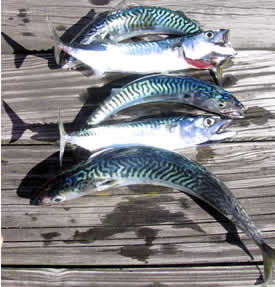
Marc Millon
Notes from a Devon Kitchen


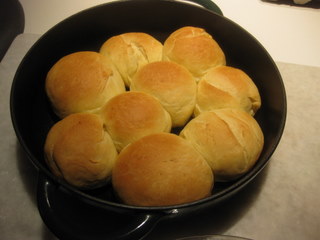






 At a given signal, the competition began to see who could woof down the greatest number of calçots (and sauce). They went about their task methodically and rhythmically, gripping the onion by its top, stripping off its charred and grill-blackened sheath, dipping it into the sauce, tipping back their heads and munching down the length of the onion.
At a given signal, the competition began to see who could woof down the greatest number of calçots (and sauce). They went about their task methodically and rhythmically, gripping the onion by its top, stripping off its charred and grill-blackened sheath, dipping it into the sauce, tipping back their heads and munching down the length of the onion. 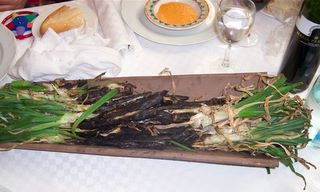 Definitely not just any old onion festival, but a feast to remember, a heart-warming, enriching experience in all senses, and the perfect way to brighten the winter days. I'm already booked in for next year.
Definitely not just any old onion festival, but a feast to remember, a heart-warming, enriching experience in all senses, and the perfect way to brighten the winter days. I'm already booked in for next year.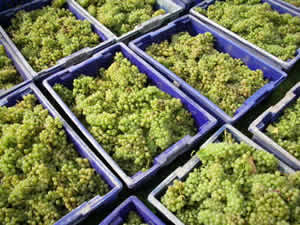

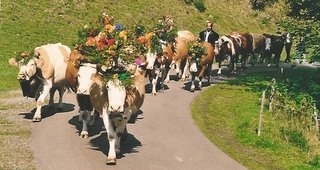
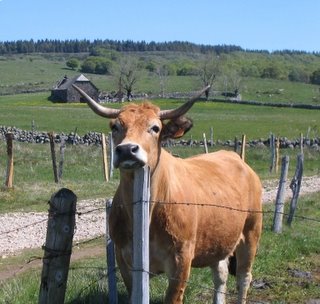
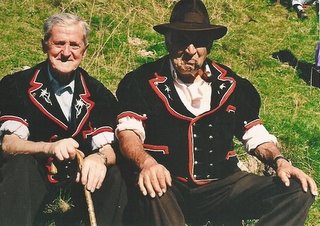


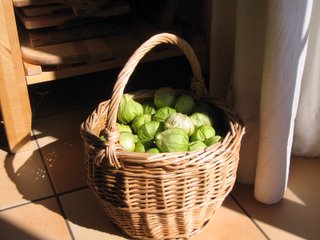
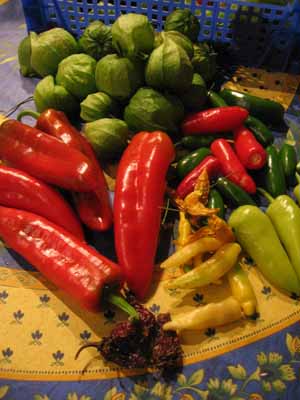



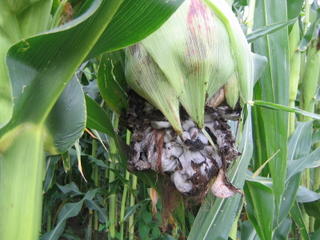 The day I get around to writing my definitive work on
The day I get around to writing my definitive work on 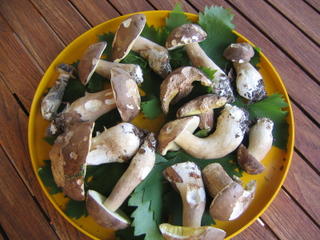 Some people say you need a dog to get you out walking. Not me. All I need is the promise of some fat fungi.
Some people say you need a dog to get you out walking. Not me. All I need is the promise of some fat fungi.